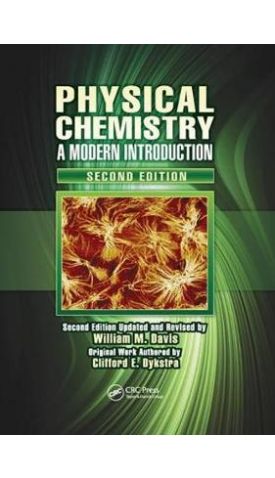אנו משתמשים ב-Cookies כדי לשפר את החוויה שלך. כדי לקיים ההנחיה החדשה של e-Privacy, עלינו לבקש את הסכמתך להגדיר את ה-Cookies. קבלת מידע נוסף.
441.00 ₪
Physical Chemistry: A Modern Introduction, Second Edition
441.00 ₪
ISBN13
9781138113992
יצא לאור ב
London
מהדורה
2nd New edition
עמודים / Pages
519
פורמט
Paperback / softback
תאריך יציאה לאור
18 בספט׳ 2018
Previous ed.: Physical chemistry / Clifford E. Dykstra. Upper Saddle River, NJ: Prentice Hall, c1997.
Designed for a two-semester introductory course sequence in physical chemistry, Physical Chemistry: A Modern Introduction, Second Edition offers a streamlined introduction to the subject. Focusing on core concepts, the text stresses fundamental issues and includes basic examples rather than the myriad of applications often presented in other, more encyclopedic books. Physical chemistry need not appear as a large assortment of different, disconnected, and sometimes intimidating topics. Instead, students should see that physical chemistry provides a coherent framework for chemical knowledge, from the molecular to the macroscopic level.
The book offers:
Novel organization to foster student understanding, giving students the strongest sophistication in the least amount of time and preparing them to tackle more challenging topics
Strong problem-solving emphasis, with numerous end-of-chapter practice exercises, over two dozen in-text worked examples, and a number of clearly identified spreadsheet exercises
A quick review in calculus, via an appendix providing the necessary mathematical background for the study of physical chemistry
Powerful streamlined development of group theory and advanced topics in quantum mechanics, via appendices covering molecular symmetry and special quantum mechanical approaches
| מהדורה | 2nd New edition |
|---|---|
| עמודים / Pages | 519 |
| פורמט | Paperback / softback |
| ISBN10 | 1138113999 |
| יצא לאור ב | London |
| תאריך יציאה לאור | 18 בספט׳ 2018 |
| תוכן עניינים | Preface Acknowledgments Author Guide for Students List of Special Examples World of Atoms and Molecules Introduction to Physical Chemistry Theory and Experiment in Physical Chemistry Atomic and Molecular Energies Configurations, Entropy, and Volume Energy, Entropy, and Temperature Distribution Law Derivation Conclusions Point of Interest: James Clerk Maxwell Exercises Bibliography Ideal and Real Gases The Ideal Gas Laws Collisions and Pressure Nonideal Behavior Thermodynamic State Functions Energy and Thermodynamic Relations Conclusions Point of Interest: Intermolecular Interactions Exercises Bibliography Changes of State Pressure-Volume Work Reversibility, Heat, and Work Entropy The Laws of Thermodynamics Heat Capacities Joule-Thomson Expansion Conclusions Point of Interest: Heat Capacities of Solids Exercises Bibliography Phases and Multicomponent Systems Phases and Phase Diagrams The Chemical Potential Clapeyron Equation First- and Second-Order Phase Transitions Conclusions Point of Interest: Josiah Willard Gibbs Exercises Bibliography Activity and Equilibrium of Gases and Solutions Activities and Fugacities of Gases Activities of Solutions Vapor Pressure Behavior of Solutions Equilibrium Constants Phase Equilibria Involving Solutions Conclusions. Point of Interest: Gilbert Newton Lewis Exercises. Bibliography Chemical Reactions: Kinetics, Dynamics, and Equilibrium Reaction of Atoms and Molecules Collisions and Transport Rate Equations Rate Laws for Complex Reactions Temperature Dependence and Solvent Effects Reaction Thermodynamics Electrochemical Reactions Conclusions Point of Interest: Galactic Reaction Chemistry Exercises Bibliography Vibrational Mechanics of Particle Systems Classical Particle Mechanics and Vibration Vibration in Several Degrees of Freedom Quantum Phenomena and Wave Character Quantum Mechanical Harmonic Oscillator Harmonic Vibration of Many Particles Conclusions Point of Interest Exercises Bibliography Molecular Quantum Mechanics Quantum Mechanical Operators Information from Wavefunctions Multidimensional Problems and Separability Particles with Box and Step Potentials Rigid Rotator and Angular Momentum Coupling of Angular Momenta Variation Theory Perturbation Theory Conclusions Point of Interest: The Quantum Revolution The Solvay Conference Exercises Bibliography Vibrational-Rotational Spectroscopy Molecular Spectroscopy and Transitions Vibration and Rotation of a Diatomic Molecule Vibrational Anharmonicity and Spectra Rotational Spectroscopy Harmonic Picture of Polyatomic Vibrations Polyatomic Vibrational Spectroscopy Conclusions Point of Interest: Laser Spectroscopy Exercises Bibliography Electronic Structure. Hydrogen and One-Electron Atoms Orbital and Spin Angular Momentum Atomic Orbitals and Atomic States Molecules and the Born-Oppenheimer Approximation Antisymmetrization of Electronic Wavefunctions Molecular Electronic Structure Visible-Ultraviolet Spectra of Molecules Properties and Electronic Structure Conclusions Point of Interest: John Clarke Slater Exercises Bibliography Advanced Texts and Monographs Statistical Mechanics Probability Ensembles and Arrangements Distributions and the Chemical Potential Molecular Partition Functions Thermodynamic Functions Heat Capacities Conclusions Point of Interest: Lars Onsager Exercises Bibliography Magnetic Resonance Spectroscopy Nuclear Spin States Nuclear Spin-Spin Coupling Electron Spin Resonance Spectra Extensions of Magnetic Resonance Conclusions Point of Interest: The NMR Revolution Exercises Bibliography Introduction to Surface Chemistry Interfacial Layer and Surface Tension Adsorption and Desorption Langmuir Theory of Adsorption Temperature and Pressure Effects on Surfaces Surface Characterization Techniques Conclusions Point of Interest: Irving Langmuir Exercises Bibliography Appendix A: Mathematical Background Appendix B: Molecular Symmetry Appendix C: Special Quantum Mechanical Approaches Appendix D: Table of Integrals. Appendix E: Table of Atomic Masses and Nuclear Spins Appendix F: Fundamental Constants and Conversion of Units Appendix G: Tables. Appendix H: Points of Interest. Appendix I: Atomic Masses and Percent Natural Abundance of Light Elements. Appendix J: Values of Constants Appendix K: The Greek Alphabet Answers to Selected Exercises Index |


Login and Registration Form